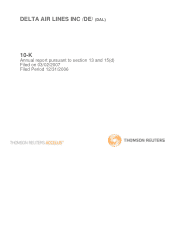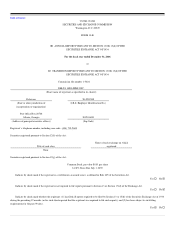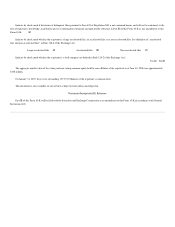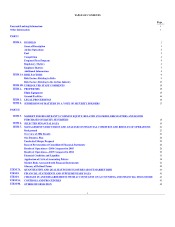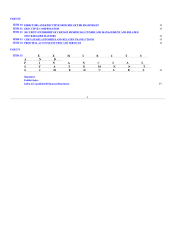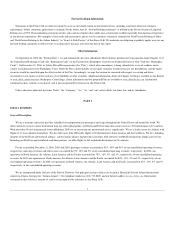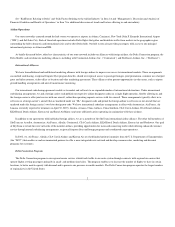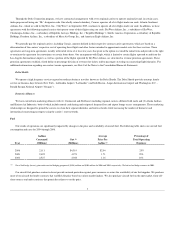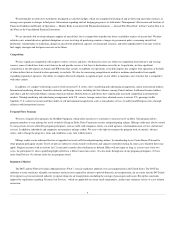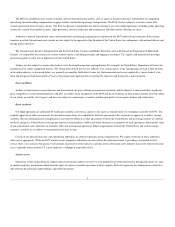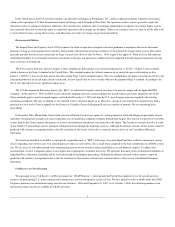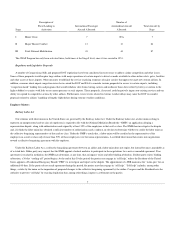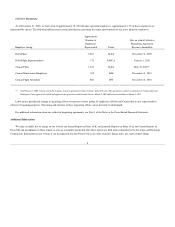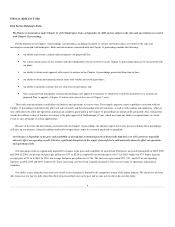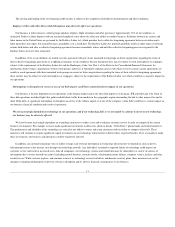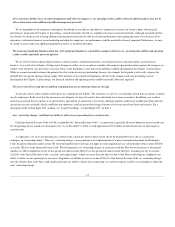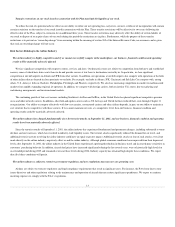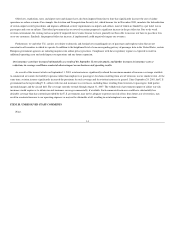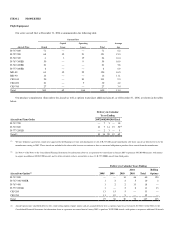Delta Airlines 2006 Annual Report Download - page 11
Download and view the complete annual report
Please find page 11 of the 2006 Delta Airlines annual report below. You can navigate through the pages in the report by either clicking on the pages listed below, or by using the keyword search tool below to find specific information within the annual report.
In the United States, the FAA currently regulates slot allocations at Reagan in Washington, D.C., and has imposed analogous regulatory mechanisms
which restrict operations at O’Hare International Airport in Chicago, and LaGuardia in New York. Our operations at these airports generally require the
allocation of slots or analogous regulatory authorities. We currently have sufficient slots or analogous authorizations to operate our existing flights, and we
have generally been able to obtain the rights to expand our operations and to change our schedules. There is no assurance, however, that we will be able to do
so in the future because, among other reasons, such allocations are subject to changes in governmental policies.
Environmental Matters
The Airport Noise and Capacity Act of 1990 recognizes the rights of operators of airports with noise problems to implement local noise abatement
programs so long as such programs do not interfere unreasonably with interstate or foreign commerce or the national air transportation system. This statute
generally provides that local noise restrictions on Stage 3 aircraft first effective after October 1, 1990, require FAA approval. While we have had sufficient
scheduling flexibility to accommodate local noise restrictions in the past, our operations could be adversely impacted if locally-imposed regulations become
more restrictive or widespread.
The FAA issued a final rule, effective August 4, 2005, adopting the International Civil Aviation Organization’s (“ICAO”) Chapter 4 noise standard,
which is known as the Stage 4 standard in the United States. This standard requires that all new commercial jet aircraft designs certificated on or after
January 1, 2006 be at least ten decibels quieter than the existing Stage 3 noise standard requires. This new standard does not apply to existing aircraft or to the
continued production of aircraft types already certificated. All new aircraft that we have on order will meet the proposed Stage 4 standard. Accordingly, the
rule is not expected to have any significant impact on us.
The U.S. Environmental Protection Agency (the “EPA”) is authorized to regulate aircraft emissions. Our aircraft comply with the applicable EPA
standards. On November 17, 2005, the EPA issued a final rule adopting emissions control standards for aircraft engines previously adopted by the ICAO.
These standards apply to newly designed engines certified after December 31, 2003 and align the U.S. aircraft engine emission standards with existing
international standards. The rule, as adopted, is not expected to have a material impact on us. However, a group of state and local air regulators has filed a
petition for review in the Court of Appeals for the District of Columbia Circuit challenging the rule on a number of grounds. We are monitoring these
proceedings.
In December 2004, Miami-Dade County filed a lawsuit in Florida Circuit Court against us, seeking injunctive relief and alleging responsibility for past
and future environmental cleanup costs and civil penalties for environmental conditions at Miami International Airport. This lawsuit is related to several other
actions filed by the County against other parties to recover environmental remediation costs incurred at the airport. This lawsuit is currently stayed as a result
of our Chapter 11 proceedings, and we anticipate settling this lawsuit through the bankruptcy process. Although the ultimate outcome of this matter cannot be
predicted with certainty, management believes that the resolution of this matter will not have a material adverse effect on our Consolidated Financial
Statements.
We have been identified by the EPA as a potentially responsible party (a “PRP”) with respect to certain Superfund Sites, and have entered into consent
decrees regarding some of these sites. Our alleged disposal volume at each of these sites is small when compared to the total contributions of all PRPs at each
site. We are aware of soil and/or ground water contamination present on our current or former leaseholds at several domestic airports. To address this
contamination, we have a program in place to investigate and, if appropriate, remediate these sites. We anticipate that many of the environmental liabilities at
Superfund Sites and former leaseholds will be resolved through the bankruptcy proceedings. Although the ultimate outcome of these matters cannot be
predicted with certainty, management believes that the resolution of these matters will not have a material adverse effect on our Consolidated Financial
Statements.
CivilReserve Air Fleet Program
We participate in the Civil Reserve Air Fleet program (the “CRAF Program”), which permits the United States military to use the aircraft and crew
resources of participating U.S. airlines during airlift emergencies, national emergencies or times of war. We have agreed to make available under the CRAF
Program a portion of our international range aircraft from October 1, 2006 until September 30, 2007. As of October 1, 2006, the following numbers of our
international range aircraft are available for CRAF activation:
6

